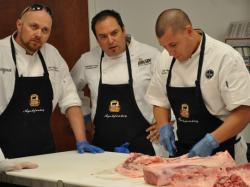What A Chef Wants: Ringside With Legendary Steaks
March 26, 2014 | 3 min to read

Chef Chris Turke checks into his RingSide Steakhouse Eastside each day with one goal in mind – giving diners who’ve chosen this restaurant an experience that will keep them coming back for more.
The career chef knows his guests aren’t coming to the Portland, Ore., steakhouse seeking a good piece of lemon-herb chicken or pork chops.
For the past 70 years, beef has undoubtedly been the driver at this legendary eatery in the Pacific Northwest, along with its elder sister, RingSide Uptown. And despite his vast culinary knowledge and cooking ability, Turke knows starting with a high-quality product is paramount to the restaurant’s success.
RingSide is known for its dry-aged steaks. Turke’s colleague, chef Beau Carr, oversees an on-premise dry-aging cooler at the uptown location, which supplies both restaurants. Guests will attest that the chefs have touched on something very special in their dry-aging conquests, helping them garner numerous accolades, both locally and nationally. Their 8-oz. filet mignon is the top-selling steak.
That kind of quality makes a great first impression, even before cooking.
“I look at the marbling and firmness,” Turke says. “You can really see how firm that muscle is. That’s important for us. I don’t know the science behind that, but it has to sit nice. Our customers are about the eye test. For them, it needs to look like it did when they were kids, so it has to hold its shape.”
But while the overall level of quality coming through his back door has remained the same, the chef admits having to flex his creativity as the overall cut size increases.
“In general it seems like beef is getting bigger – especially the New York strip and the ribeye,” Turke says. “I understand why, but it does make it challenging.”
One way he sidesteps the issue is by offering smaller portions, which appeals to younger clientele.
“A lot of times we’ll have younger couples, and they’ve really taken to communal dining,” he says. “They’ll come in, grab a four-top table and share. They’ll order an appetizer as their entrée, two sides as their app and then get two pieces of meat, cut them up and split it. So, instead of an 8-oz. and a 12-oz. filet, we now have a 6- and a 9-oz. portion. Sometimes they’ll have two, 4-oz. filets.”
Another example is Turke’s “bull nose” New York strip: a 16-oz. strip steak that’s prepared, and then split crossways post-cooking and served in 8-oz. portions. While more seasoned diners notice that the strip doesn’t exactly resemble the cut they’ve been eating for years, it allows an opportunity to give guests a nice, thick steak without a huge portion size.
“That’s been a lot of fun for us,” Turke says. “It enables us a little more creativity and gives us a greater opportunity to use ingredients we have here locally. We have a lot of Oregon-grown truffles. We’ll take those and use them in mashed potatoes, or sometimes we’ll just go tableside and slice them onto steaks.”
Portland diners have a reputation for wanting more information than most about where their food comes from. To answer this, RingSide serves only Certified Angus Beef ® brand steaks sourced from the Northwest. Those steaks are the perfect vehicle to deliver an eye-appealing dish, often garnished with produce from the garden just out the back door.
“Diners sometimes ask if we have this or that or if this contains hormones,” Turke says. “They want to know what they’re eating. I don’t think they always know what to do with the information we tell them, but they definitely ask.”
This June, RingSide is rolling out the red carpet to celebrate its 70th anniversary with a month-long list of festivities throughout National Steakhouse Month.
Nowadays, 70 years in business is a rare feat. Even more significant when you realize their biggest draw hasn’t changed since the very beginning. A love of beef – particularly high-quality beef – is the reason people keep filtering through the front doors of RingSide Steakhouse, and you can bet it will be the reason they continue to do so for another 70 years.
Source: Certified Angus Beef LLC
